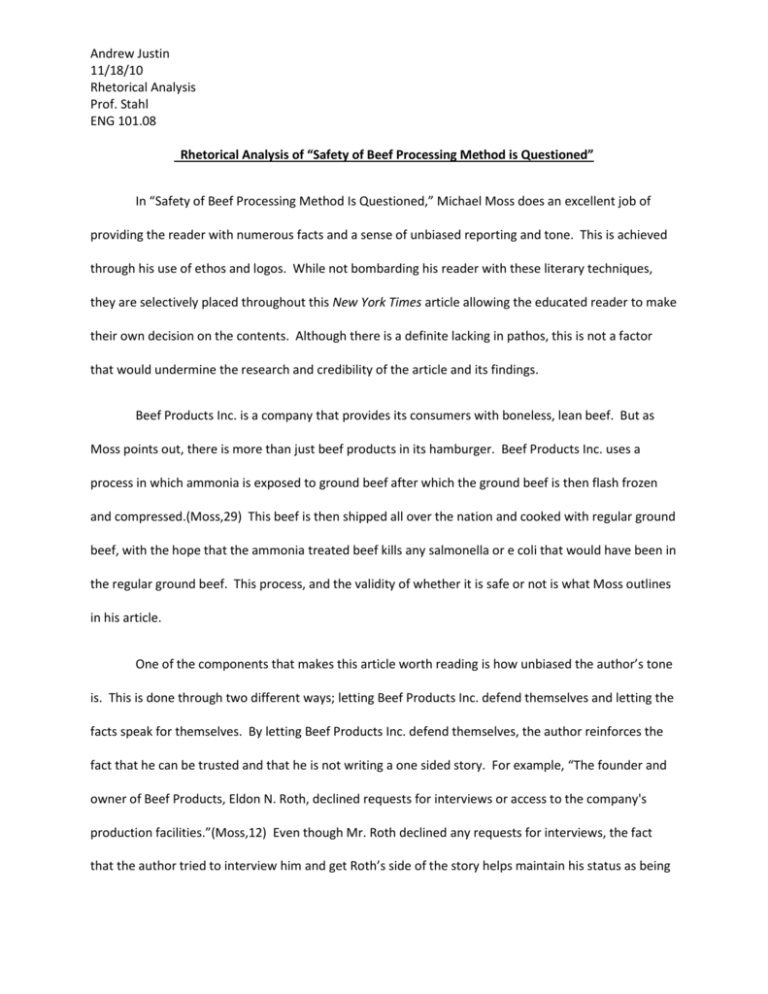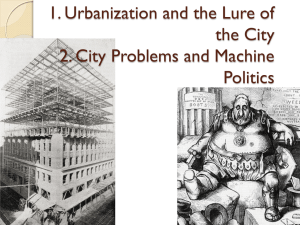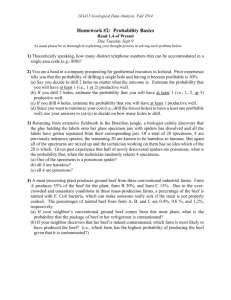Rhetorical Analysis of *Safety of Beef Processing Method is
advertisement

Andrew Justin 11/18/10 Rhetorical Analysis Prof. Stahl ENG 101.08 Rhetorical Analysis of “Safety of Beef Processing Method is Questioned” In “Safety of Beef Processing Method Is Questioned,” Michael Moss does an excellent job of providing the reader with numerous facts and a sense of unbiased reporting and tone. This is achieved through his use of ethos and logos. While not bombarding his reader with these literary techniques, they are selectively placed throughout this New York Times article allowing the educated reader to make their own decision on the contents. Although there is a definite lacking in pathos, this is not a factor that would undermine the research and credibility of the article and its findings. Beef Products Inc. is a company that provides its consumers with boneless, lean beef. But as Moss points out, there is more than just beef products in its hamburger. Beef Products Inc. uses a process in which ammonia is exposed to ground beef after which the ground beef is then flash frozen and compressed.(Moss,29) This beef is then shipped all over the nation and cooked with regular ground beef, with the hope that the ammonia treated beef kills any salmonella or e coli that would have been in the regular ground beef. This process, and the validity of whether it is safe or not is what Moss outlines in his article. One of the components that makes this article worth reading is how unbiased the author’s tone is. This is done through two different ways; letting Beef Products Inc. defend themselves and letting the facts speak for themselves. By letting Beef Products Inc. defend themselves, the author reinforces the fact that he can be trusted and that he is not writing a one sided story. For example, “The founder and owner of Beef Products, Eldon N. Roth, declined requests for interviews or access to the company's production facilities.”(Moss,12) Even though Mr. Roth declined any requests for interviews, the fact that the author tried to interview him and get Roth’s side of the story helps maintain his status as being Andrew Justin 11/18/10 Rhetorical Analysis Prof. Stahl ENG 101.08 a reliable and unbiased reporter. The second way this unbiased tone is achieved is through the mere stating of facts. By not undermining his article with any side comments or sarcastic remarks, the author gives the reader the impression that he is educated and that he is writing for educated people. One such example would be this: “Beef Products said it had submitted new research to the agriculture department showing that its treatment remained effective with lower alkalinity. Agriculture officials said Beef Products' latest study is under review.”(Moss, 22) Nowhere in this quote does the author let his feelings get in the way of letting the facts be known, allowing the reader to come up with their own educated decision on what they think of Beef Products’ tactics. Another component of this article that makes it worth reading is that it is written by an educated person, for an educated audience. When the audience reads this article there are two things that will stand out; it’s precise and articulate use of words and that it was published by the New York Times. Both factors that back up the author’s education and credibility. The first factor, the precise and articulate use of words, lets the reader know that this author knows exactly what he’s saying. A prime example of this wording would be, “The Beef Products case reveals a schism between the main Department of Agriculture and its division that oversees the school lunch program, a divide that underscores the government's faltering effort to make hamburger safe.”(Moss, 9) With this wording, Moss can get his point across to the audience without them having to second guess on what he is really saying. The second factor I would like to elaborate on would be the fact that this article was published by the New York Times. This piece of information may seem trivial, but any publication that has been awarded 104 Pulitzer prizes is a reputable one.(About the Company) One last component is the author’s use of the persuasive techniques, ethos and logos. Moss gets the point across that he is not here to swindle anyone and while doing so captures the readers Andrew Justin 11/18/10 Rhetorical Analysis Prof. Stahl ENG 101.08 trust, therefore the reader is less likely to disregard the evidence presented in the article. For example, “The founder and owner of Beef Products, Eldon N. Roth, declined requests for interviews or access to the company's production facilities.”(Moss,12) By giving the face of the company a chance to defend himself, Moss reinforces the idea that he is an honest and ethical reporter. The other technique Moss employs is logos, the use of logic to persuade your audience. A good example of this is all of the facts that are presented throughout the article and not only that, but how they are presented. For instance, “Eight years ago…injecting beef with ammonia” or “With the U.S.D.A.’s stamp of approval…as do grocery chains.”(Moss, 1) (Moss, 4) By presenting these statements in such a straightforward way, Moss lets his audience make up there own mind on the subject matter. Unfortunately the article is lacking in pathos, but what is missing in emotion the author more than makes up for with facts. After going through some of the intricate techniques Mr. Moss employs, we can see that this is an effective and informative piece of journalism. The only drawback of which is the lack of emotion presented. So whether or not you agree with the use of ammonia enhanced beef or not, we can all agree on the quality of this article. Andrew Justin 11/18/10 Rhetorical Analysis Prof. Stahl ENG 101.08 Works Cited “About the Company.” The New York Times Company. The New York Times Company. 2010. Web. Moss, Michael. "Safety of Beef Processing Method Is Questioned." New York Times 31 Dec 2009, New York edition: Print.






